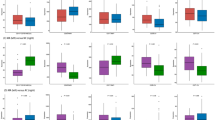Abstract
Histopathological study of bone marrow biopsy (BMB) in chronic myelomonocytic leukemia (CMML) is often difficult and might benefit from an immunohistochemical approach. We immunostained 15 cases of CMML, focusing at two new antibodies staining for CD14 and CD16 on paraffin-embedded tissues. CD68 (KP1), CD68 (PG-M1), and CD163 were not differentially expressed between CMML and chronic myelogenous leukemia (CML). In CMML BMB, we found a significant increase in the number of CD14+ monocytes. This increase was made of dispersed cells in the interstitium, often exhibiting bilobated nuclei, and being difficult to differentiate from neutrophils. There was no expansion of CD16+ monocyte-like cells. However, we found a significant decrease in the number of granulocytes expressing CD16, MPO, and CD15 in CMML compared to CML and control BMB, probably related to dysgranulopoiesis. Indeed, BMB immunohistochemistry can be helpful in CMML by identifying both the monocyte expansion with CD14 and the dysgranulopoiesis with CD16.





Similar content being viewed by others
References
Vardiman JW, Imbert M, Pierre R et al (2001) Chronic myelomonocytic leukemia. In: Jaffe ES, Harris NL, Stein H, Vardiman JW (eds) World Health Organization classification of tumors: pathology and genetics of tumours of haematopoietic and lymphoid tissues. IARC, Lyon, pp 49–52
Vardiman JW, Harris NL, Brunning RD (2002) The World Health Organization (WHO) classification of the myeloid neoplasms. Blood 100:2292–2302
Steensma DP, Dewald GW, Lasho TL et al (2005) The JAK2 V617F activating tyrosine kinase mutation is an infrequent event in both “atypical” myeloproliferative disorders and myelodysplastic syndromes. Blood 106:1207–1209
Bennett JM, Catovsky D, Daniel MT et al (1994) The chronic myeloid leukaemias: guidelines for distinguishing chronic granulocytic, atypical chronic myeloid, and chronic myelomonocytic leukaemia. Proposals by the French–American–British Cooperative Leukaemia Group. Br J Haematol 87:746–754
Fenaux P, Beuscart R, Lai JL et al (1988) Prognostic factors in adult chronic myelomonocytic leukemia: an analysis of 107 cases. J Clin Oncol 6:1417–1424
Martiat P, Michaux JL, Rodhain J (1991) Philadelpia-negative (Ph−) chronic myeloid leukemia (CML): comparison with Ph+ CML and chronic myelomonocytic leukemia. Blood 78:205–211
Geissmann F, Jung S, Littman DR (2003) Blood monocytes consist of two principal subsets with distinct migratory properties. Immunity 19:71–82
Xu Y, McKenna RW, Karandikar NJ et al (2005) Flow cytometric analysis of monocytes as a tool for distinguishing chronic myelomonocytic leukemia from reactive monocytosis. Am J Clin Pathol 124:799–806
Orazi A, Chiu R, O’Malley DP et al (2006) Chronic myelomonocytic leukemia: the role of bone marrow biopsy immunohistology. Mod Pathol 19:1536–1545
Marmey B, Boix C, Barbaroux JB et al (2006) CD14 and CD169 expression in human lymph nodes and spleen: specific expansion of CD14+ CD169− monocyte-derived cells in diffuse large B-cell lymphomas. Hum Pathol 37:68–77
Lorand-Metze I, Ribeiro E, Lima CS et al (2007) Detection of hematopoietic maturation abnormalities by flow cytometry in myelodysplastic syndromes and its utility for the differential diagnosis with non-clonal disorders. Leuk Res 31:147–155
Shao Z, Chen G, Lin Z et al (1998) Immunophenotype of myeloid cells in myelodysplastic syndromes and its clinical implications. Chin Med J 111:28–31
Manaloor EJ, Neiman RS, Heilman DK et al (2000) Immunohistochemistry can be used to subtype acute myeloid leukemia in routinely processed bone marrow biopsy specimens. Comparison with flow cytometry. Am J Clin Pathol 113:814–822
Lau SK, Chu PG, Weiss LM (2004) CD163: a specific marker of macrophages in paraffin embedded tissue samples. Am J Clin Pathol 122:794–801
Nguyen TT, Schwartz EJ, West RB et al (2005) Expression of CD163 (hemoglobin scavenger receptor) in normal tissues, lymphomas, carcinomas, and sarcomas is largely restricted to the monocyte/macrophage lineage. Am J Surg Pathol 29:617–624
Horny HP, Wehrmann M, Steinke B et al (1994) Assessment of the value of immunohistochemistry in the subtyping of acute leukemia on routinely processed bone marrow biopsy specimens with particular reference to macrophage-associated antibodies. Hum Pathol 25:810–814
Larregina AT, Morelli AE, Spencer LA et al (2001) Dermal-resident CD14+ cells differentiate into Langerhans cells. Nat Immunol 2:1151–1158
Buckley PJ, Smith MR, Braverman MF et al (1987) Human spleen contains phenotypic subsets of macrophages and dendritic cells that occupy discrete microanatomic locations. Am J Pathol 128:505–520
Yang DT, Greenwood JH, Hartung L et al (2005) Flow cytometric analysis of different CD14 epitopes can help identify immature monocytic populations. Am J Clin Pathol 124:930–936
Acknowledgments
The authors wish to thank Patricia Bonjour and Pierre-Etienne Bouchet for technical help. Marwan Qubaja is supported by a grant in cooperation between University Pierre et Marie Curie and Al-Quds University—School of Medicine.
Conflict of interest
The authors do not identify any conflict of interest to declare.
Author information
Authors and Affiliations
Corresponding author
Rights and permissions
About this article
Cite this article
Qubaja, M., Marmey, B., Le Tourneau, A. et al. The detection of CD14 and CD16 in paraffin-embedded bone marrow biopsies is useful for the diagnosis of chronic myelomonocytic leukemia. Virchows Arch 454, 411–419 (2009). https://doi.org/10.1007/s00428-009-0726-x
Received:
Revised:
Accepted:
Published:
Issue Date:
DOI: https://doi.org/10.1007/s00428-009-0726-x




